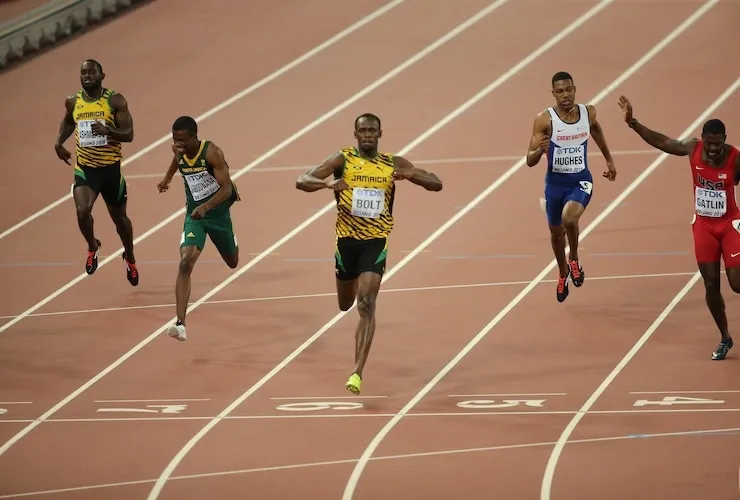Are you looking to improve your speed on the track? Whether you're a competitive athlete, a recreational runner, or simply interested in the science of speed, understanding the nuances of running 100 meters can be a game-changer for your performance.
This comprehensive guide delves into the average time to cover this short but intense distance, explores the world record for 100 meters, and examines the key factors that influence your speed.
We'll uncover practical tips for enhancing your performance, including specialized training techniques, the role of nutrition and rest, and the numerous physical and mental benefits of sprinting.
We'll address the technical aspect of measuring your time and offer insights into the equipment and methods required for accurate assessment.
By the end of this article, you'll have a comprehensive understanding of the 100-meter sprint, empowering you to optimize your performance and achieve your speed goals. Whether you're a seasoned sprinter or a novice looking to enhance your athletic ability, this guide is your roadmap to success on the track.
Key Takeaways:
- On average, it takes 10-20 seconds to run 100 meters, depending on various factors such as age, fitness level, and running technique.
- The current world record for 100 meters is 9.58 seconds, set by Usain Bolt in 2009.
- To improve your time for running 100 meters, focus on training techniques, proper nutrition, and rest.
What is the Average Time to Run 100 Meters?
The average time to run 100 meters varies across different levels of athletic competition, with elite sprinters achieving remarkable speeds and times, often surpassing Olympic qualifying standards.
The 100-meter dash is a thrilling display of explosive speed, requiring immense power and precision from the athletes. At the elite level, top sprinters can cover this distance in astonishingly quick times, often clocking under 10 seconds.
These exceptional sprinters showcase raw speed, remarkable acceleration, and technique, highlighting the crucial factors contributing to achieving such outstanding times.
As the level of competition shifts to collegiate and high school levels, the average times for the 100-meter sprint typically increase, reflecting the developmental stages of athletes and the growing mastery of the required skills.
What is the World Record for Running 100 Meters?
The world record for running 100 meters is a testament to the pinnacle of human speed and athleticism, with the current record holder being the legendary sprinter Usain Bolt.
Usain Bolt astounded the world with his remarkable feat at the 2009 World Championships in Berlin, where he blazed across the finish line in a mind-boggling 9.58 seconds, setting the current world record. This incredible accomplishment solidified Bolt's status as an icon in the sprinting world.
The history of the 100m dash has seen legendary athletes like Carl Lewis and Maurice Greene. Still, Bolt's electrifying performances have elevated the event to unprecedented excitement and spectacle.
What Factors Affect the Time to Run 100 Meters?
Many factors, including the biomechanics of the human body, sprint speed, the efficiency of the acceleration phase, intricate sprinting techniques, and the impact of air resistance influence the time to run 100 meters.
Biomechanics plays a critical role in sprinting, determining how efficiently the body generates and transfers force while maintaining stability. Muscle strength, power output, and stride length directly affect sprinting speed and performance.
The acceleration phase demands precise coordination of muscle actions and body positioning to attain maximum velocity while swiftly minimizing energy wastage. Understanding these biomechanical aspects guides sprinters in optimizing their technique and achieving peak performance.
How to Improve Your Time for Running 100 Meters
Improving your time for running 100 meters demands a comprehensive and intensive training program, often adopted by elite sprinters to enhance their sprinting technique, refine their performance in various sprint events, and optimize the acceleration phase for maximum speed.
Elite sprinters focus on honing their sprinting techniques to achieve top-tier performance, incorporating specialized drills and exercises to build explosive power and improve stride length.
Training programs also prioritize developing strength and explosiveness through plyometric exercises and weight training to maximize force production. Refining sprinting posture and arm movements is crucial in optimizing acceleration and maintaining top speed throughout the race.
What Are Some Training Techniques for Running 100 Meters?
Training techniques for running 100 meters encompass various methodologies, including mastering the utilization of starting blocks, optimizing finish time through proper form, and enhancing sprint speed through targeted drills and exercises.
Starting blocks are crucial in providing a powerful launch off the line. Athletes focus on honing their technique for explosive starts, working on their foot placement and push-off angles to gain that vital initial momentum.
Form optimization involves refining body positioning, arm swing, and leg drive to maximize speed and efficiency. Coaches emphasize maintaining proper posture and a solid core to minimize resistance and propel the runner toward the finish line with minimal effort.
Specialized exercises, such as plyometric jumps, resistance sprints, and interval training, target specific muscle groups to increase power and speed. These drills are tailored to enhance explosiveness and stride efficiency, elevating overall sprint performance.
How Can Proper Nutrition and Rest Improve Your Time?
Proper nutrition and adequate rest play pivotal roles in enhancing an athlete's sprint performance, with optimized body weight, balanced nutrition, and strategic rest ensuring improved sprint times and overall physical readiness for sprinters.
In terms of sprinting, every fraction of a second counts, and a well-managed body weight can significantly impact an athlete's speed and agility on the track. Sprinters must maintain a balanced diet, incorporating proteins for muscle repair and carbohydrates for quick energy.
Furthermore, strategic rest is essential for muscle recovery and performance optimization. Ensuring proper nutrition and rest can aid in reducing the risk of injury and enhancing sprinting capabilities.
What Are the Benefits of Running 100 Meters?
Running 100 meters offers many benefits, from the prestige of becoming a gold medalist to the opportunity to showcase exceptional speed and agility on various track surfaces, establishing sprinters as some of the fastest athletes in the world, and contributing to the excitement of field events.
Competing in the 100 meters requires a perfect blend of explosive power, speed, and technique. The thrill of crossing the finish line in record time, with spectators cheering and cameras flashing, is an experience unlike any other.
Sprinting on different track surfaces, such as synthetic tracks, grass, or even sand, poses unique challenges, adding to the allure and complexity of the sport.
The recognition of excelling in the 100 meters extends far beyond the track. It opens doors to sponsorships, endorsements, and global recognition, elevating an athlete's status to that of a sports icon. The satisfaction of knowing that years of dedication and grueling training have culminated in a triumphant sprint is incomparable.
How Does Running 100 Meters Improve Your Overall Fitness?
Running 100 meters significantly enhances overall fitness by fostering the development of advanced sprinting techniques, engaging both aerobic and anaerobic exercise systems, and elevating exercise intensity levels to optimize physical conditioning and performance.
This short yet powerful sprint targets muscular strength, power, and speed and refines the neural pathways that coordinate movement, leading to improved agility and coordination.
Integrating aerobic and anaerobic exercise systems during the sprint challenges the cardiovascular system, enhancing endurance and cardiovascular health.
The intense nature of the 100-meter sprint elevates exercise intensity levels, triggering the body's adaptation processes and improving overall physical conditioning and performance.
What Are the Mental Benefits of Running 100 Meters?
Running 100 meters instills profound mental benefits, nurturing mental strength, confidence, endurance, and unwavering focus, contributing to developing a resilient and composed mindset crucial for sprinting success.
The intense burst of speed and power required in sprinting compels the mind to adapt to quick decision-making and enhances the capacity to handle pressure. The discipline and determination needed in training for the 100-meter dash build mental resilience, fostering the ability to push through discomfort and setbacks.
As runners face the demands of this short yet explosive race, they sharpen their focus and learn to stay composed even in high-stakes situations, significantly enhancing their mental fortitude.
How to Measure Your Time for Running 100 Meters?
Measuring your time for running 100 meters necessitates using precise timing equipment and capturing critical metrics such as 100m split times and foot ground contact time, often requiring strategic positioning of blocks for optimal sprinting performance.
One of the essential aspects of measuring sprint times is utilizing state-of-the-art timing equipment that provides accurate readings in milliseconds. This may involve electronic timing gates or laser systems, ensuring the precision required for assessing sprint performance. Utilizing advanced data analysis and synchronization software further enhances the accuracy of the timings captured.
Assessing split times at various distances within the 100m sprint is crucial for understanding the athlete's performance dynamics. By strategically placing sensors or markers at specific intervals, coaches and athletes can gain insights into acceleration, top speed, and deceleration phases, facilitating targeted training and performance improvements.
Measuring foot ground contact time provides valuable information about an athlete's efficiency and power output during the sprint. Analyzing this metric involves specialized pressure-sensitive plates or force platforms that capture the duration and force of each foot strike, aiding in technique refinement and injury prevention.
Strategic placement of blocks at the start of the sprint is fundamental for optimizing the acceleration phase. Precise adjustment of the distance and angles of the blocks to match the athlete's biomechanics and preferences can significantly impact the initial burst of speed. Coaches and athletes must meticulously experiment with block settings to find the most advantageous configuration for individual performance enhancement.
The interchangeability and integration of these methodologies contribute to comprehensive sprint timing and performance assessment, guiding athletes and coaches toward refining techniques and achieving peak results.
What Equipment is Needed to Measure Your Time?
Measuring your time for running 100 meters requires specific equipment, including block pedals for sprint events, catering to the precise needs of field athletes, and ensuring a neutral position for accurate timing assessments.
Block pedals are crucial in sprint events, providing athletes with a solid and stable platform to launch themselves forward with maximum force and speed. Along with block pedals, a high-quality starting block helps anchor the athletes' feet efficiently, contributing to a powerful and explosive start.
Electronic timing systems are essential for precise measurement, incorporating accurate sensors and display screens to capture and exhibit the sprint times precisely. These systems ensure fair and reliable timing evaluations, maintaining integrity in sprint competitions.
What is the Best Way to Time Yourself for Running 100 Meters?
Timing yourself for running 100 meters is best achieved through aligning with benchmarks such as Usain Bolt's remarkable performances, striving for decent sprint times, and continuously refining your sprinting speed to achieve and surpass normal time standards.
When pursuing effective self-timing techniques, it is essential to consistently assess and analyze your performance against established benchmarks, like Usain Bolt's unparalleled records. By setting clear goals and striving for incremental improvements, you can steadily progress towards achieving and surpassing decent sprint times. This process involves continuously refining your sprinting speed through targeted training, proper form, and consistent practice to elevate your performance to exceptional levels.



